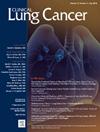Adjuvant Chemotherapy Decisions in the Treatment of Lung Cancer Considering Nonrelapse Mortality: A Multicenter Study
IF 3.3
3区 医学
Q2 ONCOLOGY
引用次数: 0
Abstract
Background
Adjuvant chemotherapy (Adj) reduces recurrence and improves long-term survival in patients with surgically resected lung cancer. However, it has minimal impact on patients who die without relapsing. To optimize Adj indications, we aimed to identify factors associated with nonrelapse mortality (NRM).
Patients and Methods
This multicenter, retrospective, observational study enrolled patients with surgically resected with stages II-III non–small cell lung cancer. Multivariable Cox regression analysis was performed to identify the factors associated with NRM and early-NRM within 2 years of surgery and to stratify the enrolled patients. Adj administration rates and postoperative overall and recurrence-free survival rates were compared. Multivariable competing regression analysis with NRM as a competing risk was used to assess the cumulative incidence of lung cancer-associated death and recurrence.
Results
Through a scoring system assigning 1 point to each extracted factor (old age, male sex, poor performance status, nonadenocarcinoma, and occurrence of major complications), the 1,244 included patients were stratified into 3 groups based on scores of 0-5: A (0-1 points; n = 613), B (2-3 points; n = 549), and C (4-5 points; n = 62) with 53%, 26%, and 11% Adj administration, respectively. Although group A showed the highest overall and recurrence-free survival rates, competing regression analysis showed no significant differences in cumulative lung cancer-associated death and recurrence incidence between the groups.
Conclusion
Better prognosis in group A was attributed to lower NRM and higher Adj administration rates. While proactive Adj may benefit group A, careful evaluation is warranted for group C to optimize Adj indication.
考虑非复发死亡率的肺癌辅助化疗治疗决策:一项多中心研究。
背景:辅助化疗(Adj)可减少手术切除肺癌患者的复发并提高长期生存率。然而,它对没有复发而死亡的患者影响很小。为了优化适应症,我们旨在确定与非复发死亡率(NRM)相关的因素。患者和方法:这项多中心、回顾性、观察性研究纳入了手术切除的II-III期非小细胞肺癌患者。采用多变量Cox回归分析,确定2年内NRM和早期NRM的相关因素,并对入组患者进行分层。两组患者的术后总生存率和无复发生存率比较。采用以NRM为竞争风险的多变量竞争回归分析来评估肺癌相关死亡和复发率的累积发生率。结果:通过评分系统对抽取的因素(老年、男性、工作状态不佳、非腺癌、主要并发症的发生)进行1分评分,将1244例纳入的患者按0-5分分为3组:a组(0-1分;n = 613), B(2-3分;n = 549), C(4-5分;n = 62),分别为53%、26%和11%。尽管A组的总生存率和无复发生存率最高,但竞争性回归分析显示,两组之间肺癌相关的累积死亡率和复发率没有显著差异。结论:A组患者预后较好,主要原因是NRM较低,肾上腺素给药率较高。虽然积极主动的Adj可能对A组有利,但对C组进行仔细评估以优化Adj指示是有必要的。
本文章由计算机程序翻译,如有差异,请以英文原文为准。
求助全文
约1分钟内获得全文
求助全文
来源期刊

Clinical lung cancer
医学-肿瘤学
CiteScore
7.00
自引率
2.80%
发文量
159
审稿时长
24 days
期刊介绍:
Clinical Lung Cancer is a peer-reviewed bimonthly journal that publishes original articles describing various aspects of clinical and translational research of lung cancer. Clinical Lung Cancer is devoted to articles on detection, diagnosis, prevention, and treatment of lung cancer. The main emphasis is on recent scientific developments in all areas related to lung cancer. Specific areas of interest include clinical research and mechanistic approaches; drug sensitivity and resistance; gene and antisense therapy; pathology, markers, and prognostic indicators; chemoprevention strategies; multimodality therapy; and integration of various approaches.
 求助内容:
求助内容: 应助结果提醒方式:
应助结果提醒方式:


